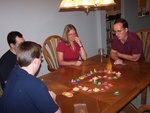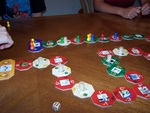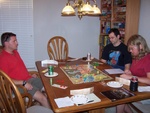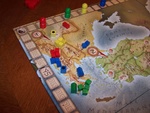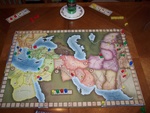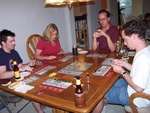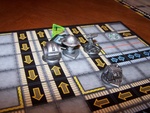
September 14, 2005Labor Day gamesby Ed Rozmiarek We use to host a big game day and cookout on Labor Day. Unfortunately, we have not been able to do this for the last three years due to soccer tournaments over the Labor Day weekend. Luckily, Mark decided to host game this year and Kevin’s soccer games finished up in time for us to go to Mark’s and get in some gaming. We use to host a big game day and cookout on Labor Day. Unfortunately, we have not been able to do this for the last three years due to soccer tournaments over the Labor Day weekend. Luckily, Mark decided to host game this year and Kevin’s soccer games finished up in time for us to go to Mark’s and get in some gaming.
That’s LifeWhile waiting for the expected people to show, we pulled out this light game. We had five and played with a random setup of tiles. Although this is a “roll & move”, there is enough tactical decision making to make it interesting and the game is short enough not overstay its welcome. I have played with both the standard setup and a random setup and prefer the random. It gives some variety to the game and it encourages people to move forward. In the standard setup, everyone hangs back trying to get the positive numbered and the “lucky charm” tiles. If you get a string of high rolls you get moved passed the good tile too quickly. With the random setup, people have more options and might be able to make something good out of any roll. Of course, as with any dice game, if the dice are against you, you’re in trouble.I was able to get and early positive tile and hang back on the start space the longest and pick up the +5 after everyone else had passed it. Later I was able to pick up two lucky charm tiles and a couple small negative tiles but Doug ran out early and was able to grab the last two lucky charm tiles and a couple of the larger negative tiles and thus pulled out the win, besting my score by 3 or 4 points. The timing worked out well and everyone showed up by the time the game was over. We had 8 and split into two groups of four. Mark had already planned on playing Wallenstein and started setting it up. We had brought our new copy of Alexander the Great and were able to get it on the other table. Alexander the GreatMike Chapel, John, Susan and I sat down to play this new game from Phalanx Games. This was the first playing for all of us. Susan and I had both read the rules but there were a little confusion in places. We had read a few questions and rules opinions on the ‘net and had walked through the turn sequence so we thought we understood how the game worked. The game mechanisms turned out to be fairly easy once we got into the game, but there are too many to describe in detail in this report. I’ll have to do a more detailed description and review after a couple more playings, for now, I’ll just cover the basics.In Alexander the Great the players recreate Alexander’s conquests through the Middle East, India and Asia. There are 6 regional campaigns that make up the game. Each campaign lasts 1 to 3 game turns. In each region there are several provinces that the players will spread out through and control. To this end, each player controls 15 resources which are used during the campaign. At the start of each campaign, the players secretly divide their resources between four areas - player turn order, armies used for area control, temple building and city building. Resources allocated to turn order control and armies are locked for the entire campaign. At the end of each game turn, unused temple and city building resources may be reallocated for the next turn, it there is one. During their turn, players move their armies into and through the provinces in the current region trying to set up majority control in the provinces. They also indicate where they would like to build a temple and/or city. Players going later in the turn have more information due to the previous players’ moves as they can see where the armies are and what building may be done. One interesting mechanism is that army movement must be paid for from the player’s temple and city building resources. So the player must make sure they plan enough for movement and building. After all of the movement, the temples and cities are built. Only one building at each location will be built. Each uncontested building gets built for minimal cost. If multiple people want to build at the same location, then only the person who allocated the most resources gets to build. However, the cost is based on the number of resources the second place person allocated, which could be a small or large amount. Therefore, one tactic is to contest someone’s building even though you don’t have more resources than them, just to make them pay a lot for the building. This reduces the number of resources that person will have next turn. Points are awarded each turn for provinces controlled and buildings built that turn. At the end of the game there are additional bonuses for the most number of temples and cities built in each region and on the entire board. The campaign ends after three turns or if at least one person moves an army into the last province. The game is interesting and flowed fairly well after the first couple turns. There was some downtime on the other players’ turns as you don’t do anything while they make their move. Since there is perfect information available to each player, everyone tended to spend time analyzing the board and options available. I’m not sure I like the variable number of turns in each campaign. One of the major decisions and tactics is deciding where to build and trying to force someone to pay a lot for a building. Since a campaign can end in one or two turns (and the length is under player control), this tactic seemed to be under used in our game. Also, the province majority scoring was a wash on many turns with each person getting a majority in one province. This happened on over half the turns. Mike stumbled into an extreme city building strategy which when left unchecked, turned out to be unstoppable. Mike got cities built in the first two campaigns. After that, he only allocated resources to armies (four) and city building. This scared everyone else away from building cities. Yes, someone needed to step up and take one for the team and contest him with is own tactic, but no one did. In the end, Mike scored a bunch of points building all of his cities and also scored several city majorities at the end of the game and won handily. The rest of us played more balanced and were closer in score. I fell back early and had to fight back. I was able to build the most temples and in the final count was able to pip Susan by 2 points for second. The game definitely needs another playing or two before giving it a rating. The good thing is I will look forward to those playings as there seems to be a decent game there. HoneybearsSusan left to pick up Kevin from a friend’s house and the Wallenstein game had a couple rounds left, so we needed a three player filler. Mike and John had not played this classic from Knizia so we pulled it out. I don’t think I have ever played this with only three players. It seemed to work fine and turned out to be just the right length with only three “races”. I was able to score well on each race and take the win. Go Red Bear!Robo Rally (x2)Robo Rally has a special spot in my gaming history. Looking back, this was the first Euro style game that we owned and played. I know it’s a stretch to call it a Euro/German game, especially since it was from Wizards of the Coast and the game play is a little heavy. However, back in 1997 or so when I first found rec.games.board and read about Robo Rally, I had to have it. Susan got it for me for my birthday or Christmas that year (which are 6 days apart and tend to blur together). We played it a bunch over the next year until we really got into Euro games the following Christmas when we picked up the Settlers card game and then Elfenland right after that. So, even though I own a complete set of original game I just had to get the new version when it came out.I am a little disappointed in some of the components; the boards are too thin and metal minis would have been better. However I do really like the new plastic flags, the player mats, the pre-made courses and having a new deck of movement cards (my original ones were starting to show some decent wear). I never had any problem with the virtual bots so didn’t really see the need for the new start board, but after playing the game, the start board works fine and is a change I can live with. We had five for the game with one robo newbie. We ended up playing two games. The first was on one of the short and easy courses. I was in contention early getting to the first just after Jon and then being first to the second (of three) flag. Unfortunately I was shot a several times by then and was forced to reboot. During that time Jon pushed and shot me up again so I lost the lead I had. Susan was able to sneak in and make it to the third flag just before Mark. We picked a harder and longer board for the second game. We also decided to start everyone off with an option. I got “Fire Control” which allowed me to lock a robo’s register when I shot them. I thought this was pretty good but it turns out that Susan got the best one, Radio Control. When she shot someone she could optionally make thar robo execute her commands not the ones they had programmed. That turned out to cause a bunch of chaos. Again I was an early leader getting to the first flag first but Susan was right behind me. She was able to use her option to reprogram my robo twice, killing me twice in the process. Throw in a couple turns of bad cards, getting shot up and rebooting, I was out of contention quickly. Meanwhile Susan used that option to take Mark out and built a big lead. It came down to Mark and Jon trying to stop Susan getting to the last flag just as I was finishing rebooting. Susan took a couple hits but made it to the last flag, taking the second game as well. Posted by Ed Rozmiarek at September 14, 2005 2:27 PMComments
Post a comment
This page viewed E-mail Ed Rozmiarek with questions or problems concerning this page. Copyright © 2005, Ed & Susan Rozmiarek. |
